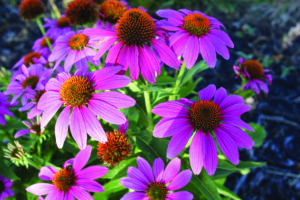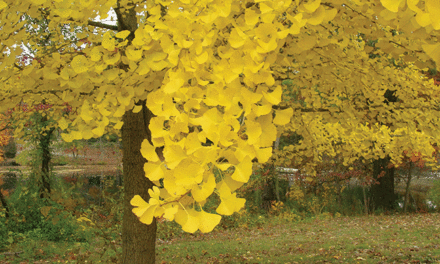
Purple coneflower thrive in full sun and well drained soils. (Photo by Ginny Rosenkranz)
Fall is a wonderful time to remember what thrived in the garden and what didn’t.
It is also a great time to see what bloomed during the summer that should be left alone, not trimmed back, so that the native song birds can feast on the flower seeds.
There are a lot of wonderful native herbaceous perennials that fill our gardens in spring, summer or fall with brilliant or soft colors and sweet or spicey fragrances.
It is always a happy surprise to see that the spent flowers that matured into seeds are now welcoming our native song birds and bring both color, movement and music into the late garden.
Summer is when Maryland’s own Black Eyed Susan’s bloom, with bright yellow petals and a small black button of fertile flowers so small we almost never even see them.
The golden yellow petals provide a wonderful landing pad for the beautiful pollinators like butterflies, and the small dark center flowers mature into the seeds that many native songbirds feast on in the late fall and into winter.
Black Eyed Susan’s thrive in full sun and well drained soils, and never seem to mind the high heat and humidity that is so common during our Maryland summers.
There are a number of beautiful cultivars that are resistant to the black spots on the foliage including “American Gold Rush,” which is compact and topped with beautiful golden yellow flowers from July through September.
It was chosen as the Perennial Plant of the Year 2023. Another beautiful cultivar is ‘Indian Summer’, with fuzzy green leaves and flowers that expand almost 3 inches across. For a different look, plant ‘Prairie Sun’ which has golden orange petals tipped with yellow and the center button of flowers are green! There are even more colorful Black Eyed Susan’s that have petals of burgundy or red, some are even double petals like ‘Cherokee Sunset’ and ‘Maya’. Once the fertile flowers have been pollinated, their seeds grow to become a wonderful source of food for many native songbirds. The bright gold and black American Goldfinch, the dapper black caped grey and white Chickadee, the sharp crested bright red Cardinal and the tiny black, grey and white Nuthatch all feast on the tiny seeds in the center buttons of the Black Eyed Susan.
Coreopsis can be one of the latest of the perennials to emerge in the springtime, waiting until it knows that the soil will stay warm. The thread leafed Coreopsis has thin leaves and a light airy growth up to 2 feet tall. They bloom with a sunny yellow daisy like flower from June through September. The flowers are only 1-2 inches wide but the bright golden yellow petals matched with the bright yellow center button of fertile flowers stands out all summer against the bright green breezy foliage. Like a lot of our prairie plants, the coreopsis is happy with high heat and humidity and is very drought tolerant.
Butterflies and other pollinators love to visit the sunny yellow flowers, and when the center flowers are pollinated, they mature into seeds that feed many songbirds like the bright red Cardinal, the tiny black, grey and white chickadee, the gold and black Goldfinch and the brown striped Sparrow.
Summer’s heat never bothers the native Purple Coneflower that thrives in full sun and well drained soils. They, like the Black Eyed Susan never minds the high heat and humidity of our Maryland summers, and can bloom from June to October. Their flowers have bright pink- purple outer petals that advertise to the pollinators that a feast is ready in the center button or cone of fertile flowers. Many butterflies and hummingbirds love to visit the colorful Purple Coneflower as well as other pollinators. The outer petals can gracefully cascade downwards or create the sun rays standing straight outward, and they can grow in shades of white, yellow, orange, red or a variety of purple-pink. The Purple Coneflower’s center cone is more dome shaped and can be brown tipped with yellow or bright orange, and when the flowers mature the seeds are loved by the bright crested Blue Jays, bright red crested Cardinals, tiny black caped grey and white Chickadee, soft grey Doves, the bright gold and black Goldfinch and the tiny brown streaked yellow winged Pine Siskin. There are a lot of lovely cultivars including ‘Kim’s Knee High’, a lovely compact plant with purple petals, ‘Avalanche’ is a shorter version with bright white petals and a yellow green cone, ‘Bright Star’ grows up to 3 feet tall with red-purple petals and a copper-orange cone, ‘Fragrant Angel’ has fragrant 4 inch wide white flowers, ‘Magnus’ has giant rosy pink-purple flowers, and Pow Wow® Wild Berry is a delightful compact plant that is covered with rosy pink flowers that rebloom without needing to be deadheaded.
In the late summer the many varieties of Joe Pye Weed grow In full sun and moist soils, some growing only 2-3 feet tall like Baby Joe Pye or Little Joe Pye, while our native Joe Pye Weed can grow 4-7 feet tall. No mater how small or how tall, the large bouquets of tiny, soft pink to purple vanilla scented flowers perfume the air from July to September, welcoming colorful butterflies and other pollinators. When the flowers finish maturing into seeds, the gardens become alive with color, movement and songs of our native songbirds who feast on the ripe seeds. Some of the birds include the tiny gold and black American Goldfinch, the spritely Carolina wren, the dark eyed, slate colored Junco, and the spiffy crested soft gray Tufted Titmouse.
Early autumn brings the bright golden yellow of the Goldenrods into bloom. There are a number of native cultivars like ‘Golden Fleece’ or ‘Fireworks’ that are well behaved in the garden, spreading slowly and filling the gardens with graceful branches covered with small tight bouquets of tiny golden yellow flowers that attract the sturdiest of pollinators, the beetles. If you think that the brightly colored goldenrod is the source of the seasonal allergies, you need to look closer to the tiny flowered Ragweed that has such light and airy pollen that it has been captured 2 miles in the sky and up to 6 miles out to sea, while the pollen of the goldenrod is so heavy only sturdy beetles pollinate it. Once the goldenrod has bloomed the seeds are feasted on by the American Goldfinch, Black-capped Chickadee, the spritely Carolina Wren, Dark-eyed Junco, the brilliantly blue Indigo Bunting, the bright red crested Cardinal, the brown streaked Pine Siskin, the tufted Titmouse and the black, yellow and white colored White-throated sparrow.
In the late autumn the bright asters shine like miniature blue, purple or pink sunbursts. Their late blooming flowers provide nectar for bees, butterflies and other late pollinators. After blooming the tiny seeds are enjoyed by gold and black American Goldfinch, the black-capped Chickadee with their unique song, the jaunty crested Blue Jay, the dark-eyed Junco, the black, orange and white Eastern Towhee, the brilliant crested red Cardinal and the white breasted Nuthatch.
It is a wonderful garden that brings color, fragrance and flight with flowers and seeds.
(Editor’s Note: Ginny Rosenkranz is a commercial horticulture specialist with the University of Maryland Extension.)




